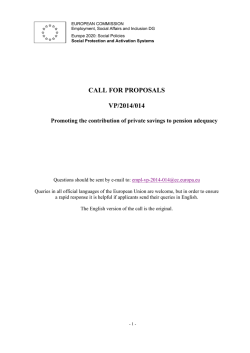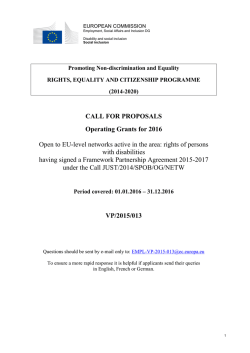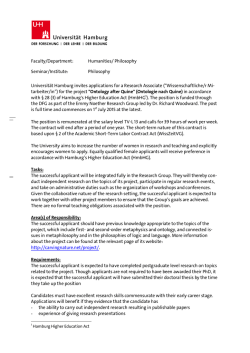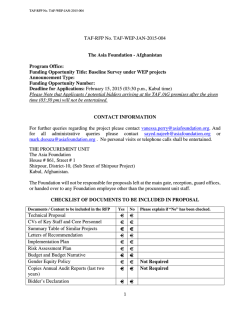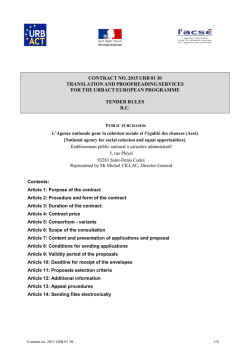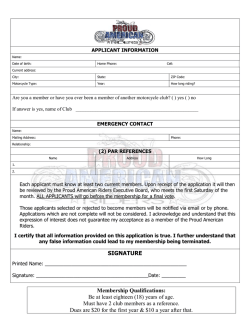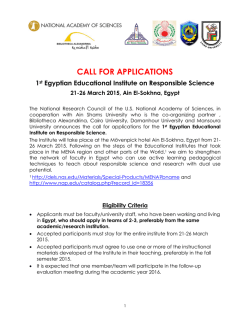
Information sharing and outreach activities to young people
EUROPEAN COMMISSION DG EMPL Directorate Employment, Social Affairs and Inclusion Unit C/2 – Sectoral Employment Challenges, Youth Employment and Entrepreneurship Budget Heading 04 03 02 01 Information sharing and outreach activities to young people about Youth Guarantee offers VP/2015/005 Call for Proposals 2015 Questions should be sent by e-mail to: [email protected] To ensure a more rapid response it is advisable to send queries in English, French or German. The English version of the call is the original. 1 CALL FOR PROPOSALS – VP/2015/005 Information sharing and outreach to young people about Youth Guarantee offers 1. 1.1. INTRODUCTION – BACKGROUND EaSI Programme The European Programme for Employment and Social Innovation "EaSI" 201420201 is a European-level financing instrument managed directly by the European Commission to contribute to the implementation of the Europe 2020 strategy, by providing financial support for the Union's objectives in terms of promoting a high level of quality and sustainable employment, guaranteeing adequate and decent social protection, combating social exclusion and poverty and improving working conditions. Within the EaSI Regulation2, it is envisaged that the EaSI Programme, in accordance with the Europe 2020 strategy, should contribute to tacking the problems of youth unemployment3 and pay particular attention to vulnerable groups, including young people4. Intervention and actions regarding youth unemployment is supported by the EaSI 'Progress' Axis, whereby a minimum of 20% of resources over the entire period of the Programme are allocated to fighting unemployment and in particular youth unemployment5. 1.2. Youth Guarantee The effects of the economic crisis on employment have been particularly marked for the European youth. At present around 5 million people in Europe under the age of 25 are unemployed and a total of 7.5 million are not in employment, education or training. This represents a huge untapped resource that Europe cannot afford to squander and carries serious implications for future growth and social cohesion. In December 2012, the Commission put forward a Youth Employment Package to assist and guide Member States in combatting youth unemployment and inactivity. Based on the Commission's proposal, the Council adopted a Recommendation on the Youth Guarantee in April 20136. Member States thereby committed to ensuring that all young people under the age of 25 receive a good-quality offer of employment, continued 1 http://ec.europa.eu/social/main.jsp?langId=en&catId=1081 2 REGULATION (EU) No 1296/2013 OF THE EUROPEAN PARLIAMENT AND OF THE COUNCIL of 11 December 2013. http://eurlex.europa.eu/LexUriServ/LexUriServ.do?uri=OJ:L:2013:347:0238:0252:EN:PDF 3 http://eur-lex.europa.eu/LexUriServ/LexUriServ.do?uri=OJ:L:2013:347:0238:0252:EN:PDF Recital paragraph 27. 4 http://eur-lex.europa.eu/LexUriServ/LexUriServ.do?uri=OJ:L:2013:347:0238:0252:EN:PDF Article 4 (2) (a). 5 Ibid: Article 14 (1) (a) 6 Council Recommendation of 22 April 2013 on establishing a Youth Guarantee (2013/C 120/01) http://eurlex.europa.eu/LexUriServ/LexUriServ.do?uri=OJ:C:2013:120:0001:0006:EN:PDF 2 education, an apprenticeship or a traineeship within a period of four months of becoming unemployed or leaving formal education. All Member States have by now presented national Youth Guarantee Implementation Plans7. Many of them set out how the Youth Guarantee will be implemented (structural reforms and other initiatives), the respective roles of public authorities, youth organisations, social partners and other organisations, how it will be financed (including the use to be made of EU funds), how progress will be monitored/evaluated and the timetable. Implementation is underway and the Youth Guarantee has already led to bold structural reforms. However, it should be accelerated and major challenges remain. The 2014 European Semester emphasised the need for strategic reforms to strengthen the capacity of public employment services, reform education and training systems, and deliver quality offers. Outreach to inactive young people has been considered a particular challenge, with 12 Member States receiving a Country-Specific Recommendations on this point. Moreover, the Youth Guarantee will not work without strong mobilization of all relevant players (including social partners, civil society and the private sector ). 1.3 Awareness-raising on the Youth Guarantee High awareness of the Youth Guarantee among young people is essential for a better outreach towards young people not registered with their respective national Youth Guarantee systems: it is a pre-condition for them to contact their relevant services and benefit from available offers. As per the Council Recommendation on establishing a Youth Guarantee, the "development of effective outreach strategies towards young people, including information and awareness campaigns with a view to catchment and registration with employment services, focusing on young vulnerable people facing multiple barriers (such as social exclusion, poverty or discrimination) and NEETs, and taking into consideration their diverse backgrounds (due in particular to poverty, disability, low educational attainment or ethnic minority/ migrant background)", are important for the success of a Youth Guarantee scheme8. This is to be achieved in partnership with relevant provision and governance stakeholders9. Moreover, the Council Recommendation on establishing a Youth Guarantee recommends that the European Commission supports information sharing and outreach activities with the setting-up of the Youth Guarantee across Member States.10 Current information dissemination efforts and activities include a dedicated Youth Guarantee section on the European Commission DG EMPL website11, containing 7 http://ec.europa.eu/social/main.jsp?catId=1090&langId=en 8 Council Recommendation of 22nd April 2013 on Establishing a Youth Guarantee, Recomendation 8. http://eur-lex.europa.eu/LexUriServ/LexUriServ.do?uri=OJ:C:2013:120:0001:0006:EN:PDF 9 Council Recommendation of 22nd April 2013 on Establishing a Youth Guarantee, Recomendations 2-7. http://eur-lex.europa.eu/LexUriServ/LexUriServ.do?uri=OJ:C:2013:120:0001:0006:EN:PDF 10 Recommendation 7 addressed to the Commission, Council Recommendation of 22nd April 2013 on Establishing a Youth Guarantee 11 http://ec.europa.eu/social/main.jsp?catId=1079 3 published Youth Guarantee Implementation Plans, reports on the state-of-play of Youth Guarantee Implementation, information on 18 small scale pilot projects as well as promotional videos, and leaflets. In addition, there are several Member States who have launched information activities, dedicated websites, and videos promoting national policies and measures in line with the Youth Guarantee12. Furthermore, in autumn 2014, the European Commission launched, pilot information and awareness raising activities in partnership with national Youth Guarantee providers in four Member States. A toolkit including a visual concept has been developed in this context, which can be used in all EU Member States with a view to disseminating information and engaging youth with the Youth Guarantee. The final outcomes and results of these pilot projects are expected for summer 2015. Nevertheless, thus far results and impact in terms of increased awareness of the Youth Guarantee in Member States remain uneven and synergies between communication about individual measures and the Youth Guarantee as a national policy could be further developed. A Flash Eurobarometer survey published in April 201413 highlighted that the Youth Guarantee suffers from a lack of visibility among its core target audience. Almost eight in ten young people had not heard of the initiative, 17% had heard of it but were not familiar with the details. Only 4% had detailed knowledge of it. Awareness was highest in Finland, Sweden and Bulgaria, lowest in France, Estonia and Hungary. 1.4 Complementarity with other Union Funding Instruments In addition to the national and EU level dissemination information sharing and outreach activities currently running regarding the Youth Guarantee, parallel Union co-funded activities are taking place to tackle youth unemployment using Union instruments and funds. Member States have a legal obligation to carry out communication and information activities in relation to the operational programmes launched with EU financial support, notably from the European Social Fund and the Youth Employment Initiative14, with a view to informing potential beneficiaries about funding opportunities in the context of these programmes15, As such, activities complementary to and consistent with other EU action are possible and may be implemented jointly with other Union instruments. It should be ensured that activities carried out under the EaSI Programme are consistent with, and complementary 12 The sites of 21 Member States can be accessed through:http://ec.europa.eu/social/main.jsp?catId=1090&langId=en Some examples include: Italy: http://www.garanziagiovani.gov.it/Media/Pagine/default.aspx , Finland: http://www.nuorisotakuu.fi/nuorisotakuu Spain: http://www.empleo.gob.es/es/garantiajuvenil/home.html and Luxembourg: http://www.jugendgarantie.lu/ 13 http://www.europarl.europa.eu/pdf/eurobarometre/2014/youth/eb_395_synthesis_youth_en.pdf, see p. 16 for national results 14 REGULATION (EU) No 1303/2013 OF THE EUROPEAN PARLIAMENT AND OF THE COUNCIL of 17 December 2013 http://eur15 lex.europa.eu/LexUriServ/LexUriServ.do?uri=OJ:L:2013:347:0320:0469:EN:PDF Articles 115 -116 As laid down in Art. 115-117 Regulation (EU) No. 1303/2013 and Article 20 Regulation (EU) No. 1304/2013. 4 to, other Union action such as the European Structural and Investment Funds16, in particular the ESF/YEI. The EaSI Regulation foresees close synergies being created between the EaSI Programme and other Union Programmes and Funds (in particular the ESF/YEI) with due diligence being taken to avoid the same eligible costs being double funded17. 2. OBJECTIVES A priority of Commission President Juncker's Guidelines is a New Boost for Jobs, Growth and Investment, which necessitates the acceleration of the implementation of the Youth Guarantee Scheme. Coupled with this, one of the objectives of the EaSI PROGRESS axis is to facilitate effective and inclusive information-sharing, mutual learning and dialogue and as such this call for proposals has the overarching objective of removing obstacles to Youth Guarantee implementation, notably by outreach, information sharing and communication activities leading to both of the following specific objectives: 1. To better inform/engage Youth Guarantee provision and governance Stakeholders by promoting two-way communication and cooperation mechanisms within a Member State and enhancing the role they can play. The relevant stakeholders in the public services, NGOs and civil society may include: employment services, career guidance providers, education and training institutions, youth support services and centres, social partners (employers and trades unions), national, regional, and local government, and youth organisations18. 2. To better inform young people about the Youth Guarantee, engage with and reach out to them, with the aim of bringing them into the Youth Guarantee service. The activities should ultimately lead to an increase in the number of young people aware of the Youth Guarantee and of those registered with relevant authorities (the national Youth Guarantee provider(s). Each applicant organisation/ institution is requested to set their own measurable objectives and to develop awareness raising and communication activities for the Youth Guarantee accordingly in their constituent Member State, which are adapted to the country's circumstances and deemed necessary to remove the remaining specific obstacles to Youth Guarantee implementation. The experience gained from the activities supported under this call for proposals19 will provide other Member States with various examples for raising awareness and of tackling challenges in Youth Guarantee implementation, with a view to creating good practices that could be replicated and adapted to their own Youth Guarantee schemes and feeding into communication on the Youth Guarantee at a European level. 16 As specified in the Common Strategic Framework lad down in regulation (EU) No 1303/2013 of the European Parliament and the Council 17 http://eur-lex.europa.eu/LexUriServ/LexUriServ.do?uri=OJ:L:2013:347:0238:0252:EN:PDF Articles 6-7 18 Please see Council Recommendation on establishing a Youth Guarantee, Articles 2 – 7 on building up a Partnership based approach. http://eurlex.europa.eu/LexUriServ/LexUriServ.do?uri=OJ:C:2013:120:0001:0006:EN:PDF 19 For a non-exhaustive list of eligible activities, please see Section 6.3 5 As per Section 1.4, this action will also complement the support provided to implementing Youth Guarantee schemes through the European Social Fund and the Youth Employment Initiative, by assisting Member States to develop transversal awareness raising, dissemination and outreach strategies as part of coherent youth employment policies under the Council Recommendation on establishing a Youth Guarantee. Further to the Youth Guarantee Recommendation, applicants can, when developing awareness raising activities, seek synergy with existing channels to reach young people, including the European Youth Portal (http://europa.eu/youth/en) and related social media (e.g. the "European Youth" Facebook profile). The EaSI Programme shall, in all its axes and actions, aim to: (a) pay particular attention to vulnerable groups, such as young people; (b) promote equality between women and men, (c) combat discrimination based on sex, racial or ethnic origin, religion or belief, disability, age or sexual orientation; (d) promote a high-level of quality and sustainable employment, guarantee adequate and decent social protection, combat long-term unemployment and fight against poverty and social exclusion. Hence, in designing, implementing and reporting on the activity, beneficiaries must address the issues noted above and will be required to provide detail, in the final activity report on the steps and achievements made towards addressing those aims. 3. TIMETABLE Stages Date and time or indicative period a) Publication of the call Beginning of May b) Deadline for submitting applications c) Evaluation period d) Information to applicants November 2015 e) Signature of grant agreement December 2015 f) Starting date of the action/ work programme (as stipulated in the grant agreement) 14/08/2015 Until end of October 2015 Within two months after signature of grant agreement 6 4. BUDGET AVAILABLE The total European Union budget earmarked for the co-financing of activities is estimated at EUR 2,000,000. Grants are expected to be in the range of EUR 400 000 per application selected. The Commission intends to fund approximately five proposals, with no more than one per Member State. The requested EU contribution cannot exceed 80% of the total eligible costs of the action. The applicant must guarantee the co-financing in cash of the remaining 20% covered from sources other than from European Union funds. Contributions in kind are not accepted as co-financing. The Commission reserves the right not to distribute all the funds available. 5. ADMISSIBILITY REQUIREMENTS Applications must be sent no later than the deadline for submitting applications referred to in section 3. Applications must be submitted in writing (see section 10), using the application form and/or electronic submission system available at https://webgate.ec.europa.eu/swim Applicants are encouraged to submit their project proposal in English to facilitate treatment of the proposals and speed up the evaluation process. It should be noted, however, that applications in all official languages of the EU will be accepted. If the proposal is in any other EU language, applicants must submit an executive summary of their proposal in English. Failure to comply with those requirements will lead to the rejection of the application. 6. 6.1. ELIGIBILITY CRITERIA Eligible applicants To be eligible, the lead or sole applicant must: – be legal persons properly constituted and registered in one of the EU Member States. – be the relevant public authority in charge of establishing and managing the national Youth Guarantee scheme, as already identified by the Member State pursuant to the Council Recommendation on Establishing a Youth Guarantee20 or must be an entity (public, private21, 20 http://ec.europa.eu/social/BlobServlet?docId=11490&langId=en 21 Any private entity, applicant or co-applicant will have to observe the "no profit rule" in respect to EU grants. An EU grant may not have the purpose or effect of producing a profit for the beneficiary. Profit is defined as a surplus of the receipts over the eligible costs incurred by the beneficiary, when the request is made for payment of the balance. 7 not-for-profit or international organisation) clearly and demonstratively designated by the aforementioned public authority22 to implement the activities included in the proposal. Proposals may involve consortiums. Any co-applicants must be: – legal persons properly constituted and registered in one of the EU Member States or other EaSI-PROGRESS participating countries-23; – a public, private, not-for profit or international organisation. Lead applicants are invited to take into account the possibility of including co-applicants from non-EU EaSI-PROGRESS participating countries. Proposals should clearly describe the coapplicants contribution to the activities planned and their added value. Legal entities having a legal or capital link with applicants, which is neither limited to the action nor established for the sole purpose of its implementation, may take part in the action as affiliated entities, and may declare eligible costs as specified in section 4.2 of the Financial Guidelines for Applicants (Annex I). For that purpose, applicants shall identify such affiliated entities in the application form. In order to assess the applicants' and co-applicants' eligibility, the supporting documents related to their legal status indicated in Annex II and, in the case of consortia a letter of commitment and a mandate are requested. 6.2. Eligible Proposals To be eligible for funding under this call, project proposals must: – comply with the European Union's rules for co-financing and guarantee a cash cofinancing of at least 20% of the total eligible costs; Project proposals, which do not comply with the above criteria, are not eligible and will be rejected. 6.3 Types of activities eligible under this call for proposals: - A core eligible activity by the lead/sole applicant is the strategy design and monitoring of the dissemination, information sharing and outreach activities. - Dissemination, information sharing and outreach activities (inter alia): 22 23 Upon submission of a letter to that effect. Please see Annex II. - EU Member States. - Iceland and Norway in accordance with the EEA Agreement - Albania, former Yugoslav Republic of Macedonia, Montenegro, Serbia and Turkey. Other Candidate and potential candidate countries, would also participate in accordance with the general principles and the general terms and conditions laid down in the Framework Agreements concluded with them on their participation in Union programmes from 2015. However it is not yet confirmed, therefore applicants and co-applicants from those countries should check with the secretariat of the call ([email protected]) regarding their eligibility. 8 o development and maintenance of a devoted national Youth Guarantee online platform (for example a website or a part of existing website), which provides regular updates on the state of play of Youth Guarantee implementation in the country, and especially where young people can find out about the opportunities available to them under the scheme (what, how, when) and where they can register. Each applicant whose Member State has not yet set up such an online platform/website should include this activity in the proposal. o The identification, documentation and dissemination of at least 5 case studies/ testimonials highlighting a success story of a person who has benefited from the YG programme, ideally covering the different types of quality offers (education, traineeship, apprenticeship and job opportunities). Each applicant whose Member State does not yet have such case studies/ testimonials at their disposal should include this activity in the proposal. o development and use of existing national 'own media' portals; o social media communication; o advertising and ambient media; o press and media relations; o distribution of information and materials via existing networks in touch with young people, such as the Eurodesk24 network of multipliers; o peer-to-peer outreach ambassadors); (involving young people e.g. as youth o events, street outreach and visits and activities in youth centres. - actions aiming at the creation and improving of networks, two-way communication, cooperation mechanisms and exchange of good practices among Youth Guarantee provision and governance stakeholders25 - conferences, seminars; - training activities. 6.4 Implementation period: Activities should commence within 2 months after the signature of the grant agreement. An indicative duration of projects should be 6 months to 18 months. Applications for projects scheduled to run for a longer period than 18 months will not be accepted. 24 25 http://www.eurodesk.org/edesk/Contact.do See Section 2, Objective 1 for list of potential provision and governance stakeholders. 9 7. EXCLUSION CRITERIA 7.1. Exclusion from participation: Applicants will be excluded from participating in the call for proposals procedure if they are in any of the following situations: (a) they are bankrupt or being wound up, are having their affairs administered by the courts, have entered into an arrangement with creditors, have suspended business activities, are the subject of proceedings concerning those matters, or are in any analogous situation arising from a similar procedure provided for in national legislation or regulations; (b) they or persons having powers of representation, decision making or control over them have been convicted of an offence concerning their professional conduct by a judgment of a competent authority of a Member State which has the force of res judicata; (c) they have been guilty of grave professional misconduct proven by any means which the contracting authority can justify including by decisions of the EIB and international organisations; (d) they are not in compliance with their obligations relating to the payment of social security contributions or the payment of taxes in accordance with the legal provisions of the country in which they are established or with those of the country of the RAO or those of the country where the grant agreement is to be performed; (e) they or persons having powers of representation, decision making or control over them have been the subject of a judgment which has the force of res judicata for fraud, corruption, involvement in a criminal organisation, money laundering or any other illegal activity, where such an illegal activity is detrimental to the Union's financial interests; (f) they are currently subject to an administrative penalty referred to in Article 109(1). 7.2. Exclusion from award: Applicants will not be granted financial assistance if, in the course of the grant award procedure, they: (a) are subject to a conflict of interest; (b) are guilty of misrepresentation in supplying the information required by the Commission as a condition of participation in the grant award procedure or fail to supply this information; (c) find themselves in one of the situations of exclusion, referred to in section 7.1. The same exclusion criteria apply to affiliated entities. Administrative and financial penalties may be imposed on applicants, or affiliated entities where applicable, who are guilty of misrepresentation. 7.3. Supporting documents Applicants must sign a declaration on their honour certifying that they are not in one of the situations referred to above, filling in the relevant form attached to the application form accompanying the call for proposals (see Annex II). 10 8. SELECTION CRITERIA Only organisations/institutions with the necessary financial and operational capacity may be awarded a grant. 8.1. Financial capacity Lead and co-applicants must demonstrate that they have the financial capacity to carry out the action: each lead and co-applicant must have access to solid and adequate funding to maintain its activities for the period of the action and to help finance it as necessary. The financial capacity of each lead and co-applicant will be assessed on the basis of the following supporting documents to be submitted with the application: – declaration on their honour (includes declaration on financial capacity to carry out the activities) ; – annual balance sheets and profit and loss accounts available from the last financial year, for which the accounts have been closed: - profit and loss accounts and balance sheet summary using the template provided in SWIM and signed by the legal representative. The verification of financial capacity will not apply to public bodies or international organisations. Grants for an action ≥ EUR 750 000, in addition: - an audit report produced by an approved external auditor certifying the accounts for the last financial year available. In the case of an application grouping several applicants (consortium), the above thresholds apply by applicants. 8.2. Operational capacity The lead and co-applicant organisation/institution must have the operational resources (technical, management) and the professional skills and qualifications needed to successfully complete the proposed action, as well as the ability to implement it. The lead and coapplicants must have a strong track record of competence and experience in the field and in particular in the type of action proposed. The operational capacity of the lead and co-applicants will be assessed on the basis of the following supporting documents: – A list of the main projects carried out in the last three years relating to the objective of the call, and in particular in the fields of information dissemination, awareness raising and the creation of effective cooperation mechanisms. In the case of work done for the European Commission, applicant organisations/institutions must also indicate the reference number of the contract and the department for which the contract was performed; – The CVs of the proposed project manager/co-ordinator and the persons who will, perform the main tasks, showing all their professional experience; Project proposals, which do not comply with the above selection criteria, will be rejected. 11 9. AWARD CRITERIA Proposals which fulfil the eligibility and selection criteria indicated above will be assessed according to the following award criteria: i. Relevance Criteria (35 points) 1. The extent to which the proposed action meets the objectives of the call; 2. The extent to which there is a clear and well-supported diagnosis of the issues addressed in the proposal and the approach suggested to address these issues; 3. Quality and efficiency of the strategy for dissemination of information by the lead and co-applicants to all relevant stakeholders and target groups. ii. Quality Criteria (20 points) 1. The clarity, consistency and feasibility of the proposed work plan, including timetable and methodology, and in particular its capacity to achieve the planned objectives through well-identified and well-planned activities with clear and attainable time-lines and key performance indicators (KPIs). 2. Proposed monitoring and evaluation of the planned activities, including quality assurance plan; 3. The overall quality, clarity, consistency and comprehensiveness of the estimated budget proposal. iii. Cost/ Efficiency Criteria (20 points) 1. The degree to which the level of output and impact of the project is proportional to the amount of the requested grant. iv. Added-Value Criteria (25 points) 1. The counterfactual benefit of a Youth Guarantee awareness campaign and communication activities in light of similar previous or existing campaigns. 2. Filling in the 'gaps' in communication and awareness outreach done so far by proposed actions/activities. 3. Collaboration with the European Commission and its established networks (such as Europe Direct). Applications with a score below 50% for award criteria i, ii, iii or iv will not be considered for award. Proposals that score below 70% of the total maximum possible mark will be rejected. Taking into account the budget available for this call for proposals, the eligible project proposals with the highest evaluation scores will be selected for the award of a grant, with due consideration to the Commission's intention to support a maximum of one proposal per Member State. 12 10. PROCEDURE FOR THE SUBMISSION OF PROPOSALS Proposals must be submitted in accordance with the formal requirements and by the deadline set out under section 3. No modification to the application is allowed once the deadline for submission has elapsed. However, if there is a need to clarify certain aspects or for the correction of clerical mistakes, the Commission may contact the applicant for this purpose during the evaluation process. The information contained in the present call document together with the Financial Guidelines for Applicants provides all the information you require to submit an application. Please read it carefully before doing so, paying particular attention to the priorities of the present call. The compulsory on-line grant application form (SWIM) as well as the other requested forms can be found at the following Internet address: https://webgate.ec.europa.eu/swim Applicants will be informed in writing about the results of the selection process. Electronic submission The Internet Web application called "SWIM" (Subventions Web Input Module) allows applicants/beneficiaries to introduce, edit, validate, submit and print grant applications, as well as requests for payments and modifications of the budget estimate. SWIM can be accessed in the following web address26: https://webgate.ec.europa.eu/swim The electronic application in the online application SWIM must be "valid". Invalid electronic applications are automatically excluded from further evaluation. In order to validate the application, click on the "send" button. This step is irreversible and must be carried out before the deadline. For further information regarding SWIM and electronic submission, please consult the Financial Guidelines for Applicants (Annex I). AND Submission on paper Application not submitted online as well as by registered mail or hand delivery by the deadline indicated in section 3 ("Timetable") will not be considered by the Evaluation Committee. Please make sure that the full set of the application form and all accompanying documents are sent by post by the deadline. The absence of any of the documents mentioned in the Annex II may invalidate the application. The applicant's attention is 26 For more technical details on using SWIM, a user's manual is available on-line 13 also drawn to the fact that incomplete, unsigned or hand-written forms will not be taken into consideration. Applications sent by fax or e-mail will not be accepted. Additional documents sent by post, by fax or by electronic mail after the deadlines mentioned above will not be considered for evaluation unless requested by the European Commission. Applications shall be submitted on the correct form, duly completed, dated, showing a balanced budget (revenue/expenditure), submitted in 2 copies (one original clearly identified as such, plus 1 copy), and signed by the person authorised to enter into legally binding commitments on behalf of the applicant organisation. Where applicable, all additional information considered necessary by the applicant can be included on separate sheets. Applications must be sent to the following address: Call for Proposals VP/2015/005 Budget Line 04 03 02 01 European Commission DG EMPL/ C.2 J-27 06/066 Rue Joseph II, 27 Brussels 1049 Belgium. - Please send your application by registered mail or express courier service only and keep proof of the date of sending (the date of the post office stamp or express courier receipt will be considered as proof of the date of sending). Please submit your application by 24:00 UTC +1 on the 14/08/2015. - Hand-delivered applications must be received by the European Commission at the latest on the last day for submission. The only address for hand delivery of documents to the European Commission is: Avenue du Bourget n° 1, B-1140 Evere, Belgium27 (although in any case, the package must be labelled with the DG EMPL address above). Proof of delivery is a signed receipt from the Commission's Archives Service stamped with the date of the last day for submission or earlier (on the 14/08/2015). When sending the hard copy, applicants are requested to number the accompanying documents to be submitted with the application according to the sequence in the checklist 27 http://ec.europa.eu/contact/mailing_en.htm 14 in Annex II. Documents should be printed double-sided, if possible. Only two-hole folders should be used. The dossier should not be bound or glued. The reference of the call for proposals must be indicated on the envelope. 11. CONTACT AND PRACTICAL PROCEDURES Contacts between the contracting authority and potential applicants can only take place in certain circumstances and under the following conditions: Before the final date for submission of proposals, at the request of the applicant, the Commission may provide additional information solely for the purpose of clarifying the nature of the call. Any requests for additional information must be made by e-mail only to [email protected] , indicating the reference VP/2015/005 To ensure a more rapid reply, it would be helpful if the requests for additional information are sent in English. Our contact points are: - E-mail: [email protected] - E-mail: [email protected] (for technical problems) Questions may be sent to the above address no later than 10 days before the deadline for the submission of proposals. The Contracting Authority has no obligation to provide clarifications to questions received after this date. Replies will be given no later than 5 days before the deadline for submission of proposals. No individual replies to questions will be sent but all questions together with the answers and other important notices in the course of the evaluation procedure, will be published on the Europa website: http://ec.europa.eu/social/main.jsp?catId=629&langId=en . It is therefore advisable to consult the abovementioned website regularly in order to be informed of the questions and answers. In the interest of equal treatment of applicants, the Commission cannot give a prior opinion on the eligibility of an applicant or an action or on the outcome of the call before the official publication of results. The Commission may, on its own initiative, inform interested parties of any error, inaccuracy, omission or other clerical error in the text of the call for proposals. Rejected applications Unsuccessful applicants will receive a letter stating the reasons for refusal. Selected applications Successful applicants will receive two original copies of the grant agreement for acceptance and signature. Both these copies must be sent back to the Commission, which will then return one to the applicant once it has been signed by both parties. The work programme and the budget annexed to the grant agreement sent for signature to the successful applicant may differ from the proposal as submitted by the applicant. Therefore the applicant should carefully read the whole agreement, and the work 15 programme and budget sections in particular, before signing and returning the copies to the Commission. Participation of the Commission in project events Following the award of a grant, if the successful applicant would like the Commission to participate in any project events, the applicant must take immediate contact (in any case, at least 2 months before the event) with the Commission official responsible for following the action (named in the letter accompanying the grant agreement). The successful applicant should therefore not finalise the programming of such events without the Commission's prior approval and confirmation of its participation. The Commission's acceptance of the grant application does not prejudge its decision on whether to attend an event included in the work programme. Such a decision is always subject to a separate examination of the event programme and prior agreement on the dates and practicalities. In this context it should be noted that the probability of Commission officials participating in project events will be higher if the latter take place in Brussels. 12. SOURCES OF FUNDING In order to achieve a wider dissemination of project results, the elements concerning, inter alia, the project description, results and methodology, provided by the beneficiary in the "executive summary" part of the final report, may be published on the European Commission's website. Beneficiaries must acknowledge in writing that the project has been supported by the European Union Programme for Employment and Social Innovation ("EaSI") 2014-2020. In practice, all products (publications, brochures, press releases, videos, CDs, posters and banners, and especially those associated with conferences, seminars and information campaigns) must state the following: This (publication, conference, video, xxx) has received financial support from the European Union Programme for Employment and Social Innovation "EaSI" (20142020). For further information please consult: http://ec.europa.eu/social/easi The European emblem must appear on every publication or other material produced. Please see: http://ec.europa.eu/dgs/communication/services/visual_identity/pdf/use-emblem_en.pdf Every publication must include the following: The information contained in this publication does not necessarily reflect the official position of the European Commission. 13. MONITORING The Commission, with the support of an external contractor, will monitor regularly the EaSI Programme. Therefore, beneficiaries will have to transmit qualitative and quantitative monitoring data on the results of the activities. These will include the extent to which the principles of equality between women and men has been applied, as well as 16 how anti-discrimination considerations, including accessibility issues, have been addressed through the activities. Related templates are attached or will be provided. In setting up the action, beneficiaries must foresee the necessary funding for monitoring and reporting to the Commission. Annexes to the Call document: - Financial Guidelines for Applications - Checklist of documents to be provided - Model grant agreement (PDF) - EaSI Final technical report template (PDF) - Model for Tender Specifications for sub-contracting expertise 17 Annex I Financial Guidelines for Applicants: http://ec.europa.eu/social/main.jsp?langId=en&catId=629&callId=435&furtherCa lls=yes The Financial Guidelines for Applicants provide more detailed information for the applicants, especially as regards guidelines for presenting the proposal's provisional budget along with the rules governing which categories of expenditure are eligible and which are not. 18 Annex II - Required Documents This table includes the documents that must be provided for the application to be eligible and where originals are required. We strongly recommend using the table as a checklist in order to verify compliance with all requirements. Notes: highlighted documents do not need to be provided by public entities or international organisations. Documents marked with * are obligatorily to be attached online in SWIM as well. Checklist Originally signed third Associate Partner/ party Specification and context Affiliated entity Document Co-Applicant No. Lead Applicant The document must be provided by each Official cover This letter must quote the reference of the call for proposals, be originally signed by the letter of the authorised representative and include the proposal reference number generated by SWIM application (e.g. VP/2015/005/xxxx) _ _ _ Signed SWIM application form submitted online The SWIM application form submitted online must be printed and bear the original signature of the authorised legal representative. Note: the online form must be electronically submitted before printing. After electronic submission, no further changes to the application are permitted. _ _ _ 3. Declaration on The template is available in SWIM and must be written on the official letterhead of the honour* organisation, bearing the original signature of the authorised legal representative. _ _ 4. Letter mandate* _ _ _ 1. 2. of The template is available in SWIM and must be written on the official letterhead of the organisation, bearing the original signature of the authorised legal representative. 19 Legal/capital link with lead Affiliated entities are required to provide proof of the legal and/or capital link with the or co- lead or co-applicant. applicant* _ _ _ _ entity The template is available in SWIM and online (http://ec.europa.eu/budget/contracts_grants/info_contracts/legal_entities/legal_entities_e n.cfm) and must be duly signed by the legal representative. _ _ Proof of A certificate of official registration or other official document attesting the establishment registration of the entity (for public bodies: the law, decree, decision etc. establishing the entity). _ _ _ Statutes The articles of association/statutes or equivalent proving the eligibility of the organisation. _ _ _ VAT certificate A document showing the identification number for tax purposes or the VAT number, if applicable. _ _ _ Financial identification form* The template is available in SWIM and online (http://ec.europa.eu/budget/contracts_grants/info_contracts/financial_id/financial_id_en.cf m) and must be duly signed by the account holder. _ _ _ 11. Description of The template is available in SWIM which must be duly completed and submitted the action* electronically together with the online submission form and on paper as well. _ _ _ _ 12. Letters of commitment* _ 5. 6. 7. 8. 9. 10. Legal form* The template is available in SWIM and must explain the nature of the organisation's involvement and specify the amount of any funding provided. The letter must be written on the official letterhead of the organisation and bear the original signature of the legal representative. 20 13. 14. 15. 16. 17. Contracts for implementing the action* _ _ Balance sheet The most recent balance sheet and profit & loss accounts, including assets and liabilities, & profit and specifying the currency used. loss accounts _ _ _ Simplified The template is available in SWIM and must be signed by the authorised legal balance sheet representative & profit and loss accounts _ _ Curricula vitae CVs of the person responsible for managing the action (named in section A.3 of the of key staff online application form) and the persons who will perform the main tasks (named under "Management/Coordination" under "Heading 1 – Staff costs" of the budget in the on-line application form). The CVs should indicate clearly the current employer. _ _ List of main A list of the main projects carried out, if any, in the last three years relating to the subject projects of the call and other than those already indicated in the SWIM online application form (section D.3). _ _ _ _ _ _ _ _ Audit report 18. 19. The template is available in SWIM. Only if applicable: In case of subcontracting for external expertise where the value of external contracts exceeds EUR 5 000, detailed information on the reasons and tasks to be subcontracted and about the selection procedure of the subcontractor must be included (English, French or German). Organisations wishing to recruit the services of external experts for an amount above EUR 60 000 must provide, in addition, a copy of the draft tender specifications. A model is included in Annex V of this call. For grant requests of EUR 750,000: an external audit report produced by an approved auditor, certifying the accounts for the last financial year available. The threshold applies to each co-applicant in line with their share of the action budget. Letter of In cases where the Public Authority in charge of establishing and managing the national designation by Youth Guarantee scheme (as already identified by the Member State pursuant to the Public Council Recommendation on Establishing a Youth Guarantee) is not the lead or sole applicant, a letter from the aforementioned Public Authority should be submitted, clearly 21 Authority designating another entity as the lead or sole applicant, who will implement the activities included in this proposal. 22 ANNEX III Model Grant Agreement: http://ec.europa.eu/social/main.jsp?langId=en&catId=629&callId=435&furtherCa lls=yes 23 ANNEX IV EaSI Final technical report template: http://ec.europa.eu/social/main.jsp?langId=en&catId=629&callId=435&furtherCa lls=yes 24 ANNEX V MODEL FOR TENDER SPECIFICATIONS FOR SUBCONTRACTING EXTERNAL EXPERTISE Tender Specifications – …………… 1. Background 2. Purpose of the Contract 3. Tasks to be performed by the Contractor 3.1. Description of tasks 3.2. Guidance and indications on tasks execution and methodology 4. Expertise required 5. Time schedule and reporting 6. Payments and standard contract 7. Price 8. Selection criteria 9. Award criteria The contract will be awarded to the tenderer whose offer represents the best value for money - taking into account the following criteria: ………………………. ……………………… ……………………… It should be noted that the contract will not be awarded to a tenderer who receives less than 70% on the Award Criteria. 10. Content and presentation of the bids 10.1. Content of the bids 10.2. Presentation of the bids 25
© Copyright 2024
